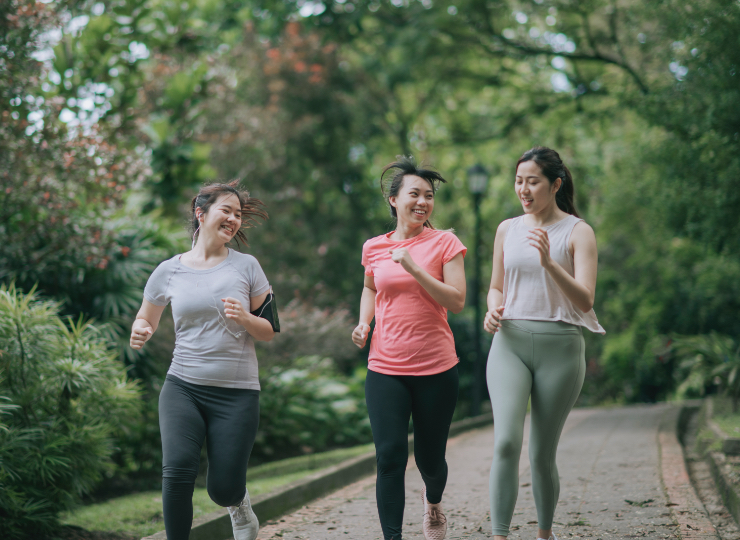
Making exercise an enjoyable part of your everyday life may be easier than you think.
If you’re having trouble starting an exercise routine or following through, you’re not alone. Many of us struggle to get out of the sedentary rut, despite our best intentions.
You already know there are many great reasons to exercise — from improving energy, mood, sleep, and health to reducing anxiety and stress. Whatever your age or fitness level — even if you’ve never exercised a day in your life — there are steps you can take to make exercise less intimidating and more instinctive.
Here are five tips you can follow to put exercise on autopilot.

How fit are you? See how you measure up with a few simple tests.
Why do it: You probably have some idea of how fit you are. But knowing the specifics can help you set realistic fitness goals, monitor your progress, and maintain your motivation. Once you know your starting point, you can plan where you want to go.
How: The results classifications (excellent, good, fair and poor) given for each of these 3 tests are based on the average scores of healthy adults, so use them as general guidelines. To have a deeper insight into assessing your fitness levels, check out these articles: “Target Heart Rate and Estimated Maximum Heart Rate”, “How Fit Are You? See How You Measure Up” and “Using the Cooper Test 12-Minute Run to Check Aerobic Fitness”.

Creating fitness goals is one way to give yourself direction and motivation, and set yourself up for success.
Why do it: Getting fit and toning up are great reasons for exercising, but what do these terms actually mean? If you think about it, they are arbitrary expressions that don’t really mean much. Chances are you’ll get on much better with making exercise a habit if you have specific goals in mind.
How: When you have one or several goals, you can focus on what you'd like to change and what needs to be done in order to achieve it. Examples include:
Choose exercise activities that will take you toward your goals. Make your goals challenging but realistic, and reward yourself when you reach them. Once you have reached your goals, what do you do? Set new ones of course! You can choose elevated versions of your original goals or a whole new set of targets, it’s up to you.

The best sort of physical activity is the one you enjoy, because that is the one that you’ll maintain.
Why do it: If you want to make exercise a habit, choose activities that you enjoy. Because even if an activity is good for you, you are unlikely to stick with it if you don’t enjoy it,
This will take some time and experimentation, but remember that the key is to create your workout habit around activities you enjoy.
How: Try different things so you eventually hit upon the fitness activities that get you excited about exercising. Don’t worry if this means you are bouncing from one activity to the next for a few months — once you hit on the right activities, you’ll soon become a fitness convert.
For example, if you find running uncomfortable or boring, don’t give up exercising completely. Instead, find an alternative activity. Consider riding a bike, participating in sports like tennis, basketball or badminton, signing up for group workout classes, hiking, dancing, martial arts or indoor rock climbing. Remember, the best exercise is the one you actually have fun doing!

You’ll be more motivated and even have a laugh in the process when you work out with friends.
Why do it: Workout pals really do work — recruiting a motivated training partner is an awesome way to make exercise more of a habit and keep you honest in your workouts.
You’re unlikely to leave your training buddy hanging, which means it’s much harder to skip out on a workout. If you were going alone and decided to skip your workout, no one else would know but you.
Training partners can also help distract you when you are feeling the burn, provide encouragement, push you to work harder, and keep you safe by making sure you don’t hurt yourself when you are working hard.
How: Be a little discerning when selecting a training partner. Make sure they are of a similar level of fitness, reliable, interested in the same activities, share similar fitness goals, and make good company.
A good training partner can astronomically increase the odds of you exercising and massively boost your workout enjoyment and results.

Research shows that self-compassion increases the likelihood that you’ll succeed in any given endeavour.
Why do it: You didn’t get out of shape overnight, and you’re not going to instantly transform your body either. Expecting too much, too soon only leads to frustration. Try not to be discouraged by what you can’t accomplish or how far you have to go to reach your fitness goals. Instead of obsessing over results, focus on consistency.
When you’re just starting to exercise, it’s important to give yourself immediate rewards when you successfully complete a workout or reach a new fitness goal. By starting with small achievable goals, you will increase your chances of success. Rewarding yourself for exercising can also be an effective way to help keep you on track, and create internal motivation.
How: Maintain a positive approach and start with easy first steps, e.g. do one wall squat every morning. The idea is to get used to moving and gradually work your way up — from one wall squat, to five, to a full 15-minute routine.